Shokupan awe: How to make Japanese milk bread (and its cult sandos)
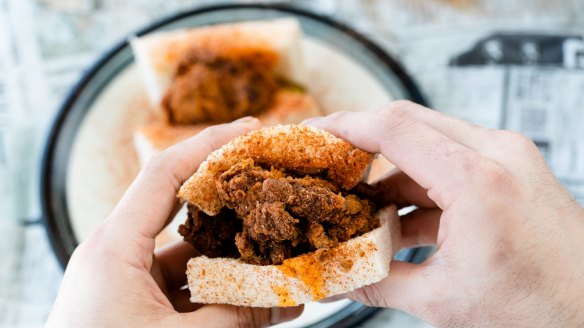
Note to self and everyone else: it's time to add soft white bread to the long list of things Japan does better than the rest of the world. We're talking shokupan – or milk bread – the most sought-after soft carb since sourdough became a staple in major supermarket trolleys.
Why is white, fluffy Japanese sandwich bread big in Australia? Why have we, as a bread-loving nation, so quickly embraced this soft, white confection? Perhaps it's the fluffy texture, so far removed from the dense, malty sourdoughs we now treat as part of our daily ritual. Perhaps it's a comfortingly nostalgic reminder of the style of bread generations of Australians had in their lunch boxes. Maybe it's because it's just so damn cool.
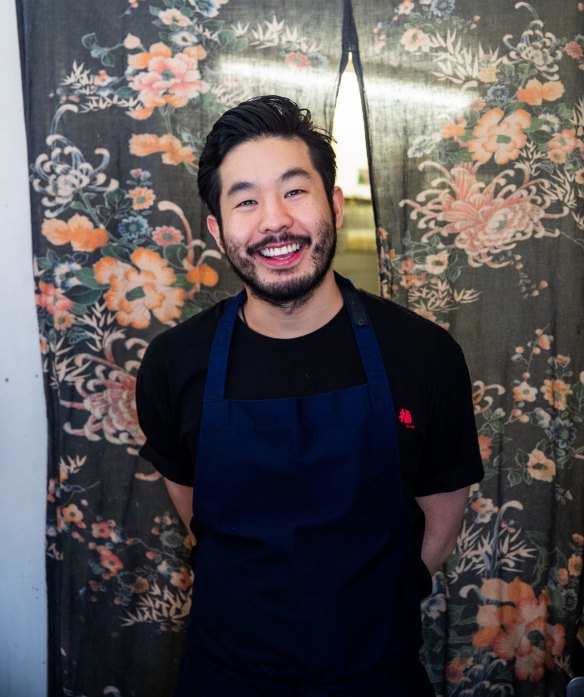
Even though it's relatively new to Australian cafes, bakeries and supermarkets, milk bread has been a shelf item in Japan since the end of World War II – a hangover from American occupation, when GIs were hankering for that good ol' industrialised white bread they grew up with back home.
And while shokupan (which means, quite literally, "food bread") started as a necessity borne of ready access to imported wheat and powdered milk, it's gradually become an art form in its own right. In her 2017 story A Brief History of Toast in Japan, American food writer Shane Mitchell describes those white sandwich loaves as "the most unlikely cross-cultural phenomenon".
Melbourne-based baker Satoshi Narusawa has been running a wholesale shokupan business called Little Cardigan since 2018, supplying the likes of CBD cafe Saint Dreux (shut during stage 4 restrictions).
You need flavour. And texture. And the right ratio of bread, sauce and protein. It's not just a sandwich.Pureephat 'Bhas' Kraikangwan
Though his regular bread-baking, at Fitzroy North's Loafer Bread, is more about naturally leavened doughs, it's his shokupan that has inspired other bakers such as Quentin Berthonneau, of Prahran Market boulangerie Q le Baker, to give it a go.
"The first time I tried Satoshi's shokupan I was just blown away by the texture," says Berthonneau. "I thought to myself, 'wow, that's amazing. I want to find a way to make it without the dry yeast.'"
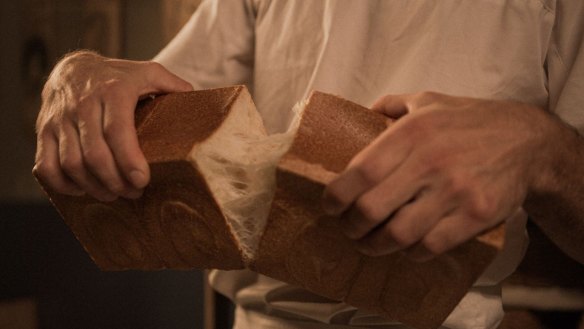
So he set about making a traditional loaf, but with a sourdough starter. It was partly for the nutritional benefits, partly for the flavour that comes with naturally occurring yeast, and partly to improve the bread's digestibility. "I've been a baker for 10 years now, and that is really important to me."
Shokupan started as a COVID-19 side hustle for Berthonneau, but it has proven to be quite a beast. Such is the hunger for the French baker's bread (only 40 loaves are available each week online) that he has a waiting list of hundreds.
But the baker refuses to bake milk bread more than twice a week. Instead, he's started running on-site workshops so businesses can make it for themselves.
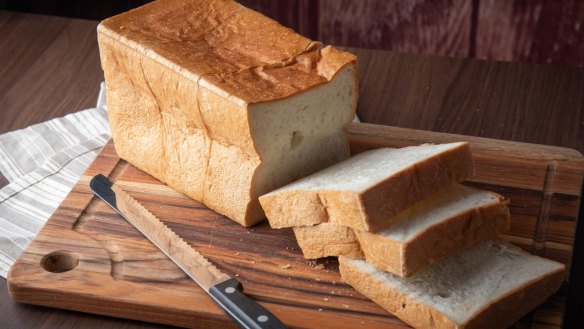
So what's the difference between shokupan and a loaf of white bread from the supermarket? On looks alone, they seem almost interchangeable.
And to be fair, it's not the most nutritious bread choice you can make. Certainly, the mix of sugar, butter and milk, along with the white flour and salt used to create the thin, almost non-existent crust encasing a billowing, soft crumb that disappears on the tongue is not quite as wholesome as the naturally occurring yeast and rye or wholegrain flour you'd find in a loaf of sourdough.
It is, however, arguably the greatest bread with which to create a finger sandwich.
Enter the sando. The Japanese sandwich once sold in convenience stores to satiate hungry commuters now commands a cult-like following in cafes across Sydney and Melbourne.
When made correctly, sandos (short for sandoitchi, or sandwich) are a study in precision – they're beautiful, technical and architectural.
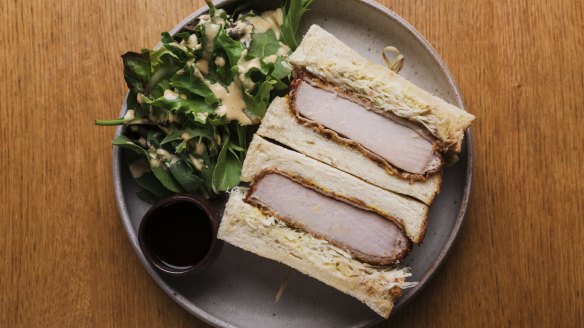
Their most addictive incarnations come filled with breaded and fried chicken or pork, but Cafe Monaka in Sydney's Mona Vale offers Japanese-style scrambled eggs and crisp-fried prawns on the soft white bread, and Fitzroy cafe Calere Coffee offers a soft-shell crab sando, just to kick it up a notch.
At Surry Hills sandwich bar Sandoitchi, there's a queue from 11.30am daily for their buttermilk-fried chicken sando (see recipe below), their dessert sando of whipped cream encasing yuzu-soaked strawberries, and the Japanese-style scrambled egg showered, in season, with truffle shavings.
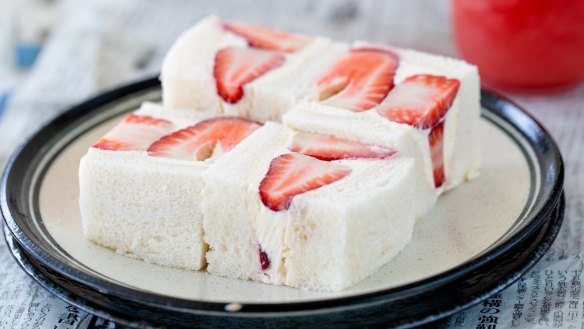
The sando is a serious business here, and one that chef Pureephat "Bhas" Kraikangwan is passionate about sharing. The ex-chef of Nahm (Bangkok), Ms G's and Mr Wong (Sydney) is now a sous chef at the Sydney branch of Long Chim while running the cafe.
Kraikangwan might be Thai, but he grew up surrounded with Japanese friends and Japanese culture. There was never a question for him that he would open anything but a Japanese-inspired venue, although if you look closely, though, the building of flavour and texture is heavily Thai.
The brine on the buttermilk chicken sando, for instance, is a fragrant mix of lemongrass, coriander root and palm sugar. He makes a Thai-style prawn mousse for another of his sandos.
The essential things for putting together a sando? "You need flavour," says Kraikangwan. "And texture. And the right ratio of bread, sauce and protein. It's not just a sandwich."
If you're of a mind to semi-make your own, Vic's Quality Meat will deliver a DIY pork katsu sando kit right to your door whether you're in Sydney, Melbourne or Geelong (plans are afoot to deliver nationally). It comes complete with Japanese-style bread, panko-crumbed pork loin steaks and Bull-Dog tonkatsu sauce, Japan's answer to barbecue sauce.
- Adam Liaw's pork katsu sando recipe (pictured below)
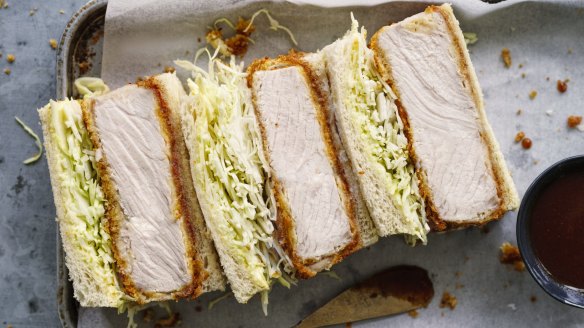
Where to buy shokupan
Tokyomart (NSW)
An extensive range of Japanese ingredients and fresh foods, including shokupan. 27/79-113 Sailors Bay Road, Northbridge.
Breadtop (NSW/VIC)
Soft, sweet breads are the catch cry here, with stores across Sydney and Melbourne. breadtop.com.au
Azuki (NSW)
A cafe and bakery offering a broad range of Japanese cakes and breads. Shop 3, 63-71 Enmore Road, Newtown. azukibakery.com.au
Fujimart (VIC)
A Japanese supermarket stocking all the essentials including squishy milk bread. 34a Elizabeth Street, South Yarra, shop-vic.fujimart.com.au
Shokupan (VIC)
Join the waitlist for one of just 40 sourdough shokupan loaves made each week. shokupan.com.au
Little Cardigan (VIC)
Usually wholesale only, DM Satoshi Narusawa (@naaaaaaaru) on Instagram to find out where to try his bread.
Where to try a sando
Sandoitchi (NSW)
Take a friend, order a strawberry sando and a buttermilk sando and have a walking picnic.
Shop 3, 113-115 Oxford Street, Darlinghurst, 0491 092 958, sandoitchi.com.au
Cafe Monaka (NSW)
The go-to order is scrambled eggs and tempura prawns on shokupan – an open-face sando, if you will.
Shop 2, 24 Waratah Street Mona Vale, 02 9999 0836
Shokupan colabs (VIC)
Every few weeks, Quentin Berthonneau runs collaborations with venues around Melbourne.
Check his Insta (@quentinbbaker) for latest updates; shokupan.com.au
Calere (VIC)
Four sandos on the menu (soft-shell crab! chicken and gai lan!) makes every day you visit a carb-filled adventure.
166 Gertrude Street, Fitzroy, calerecoffee.square.site
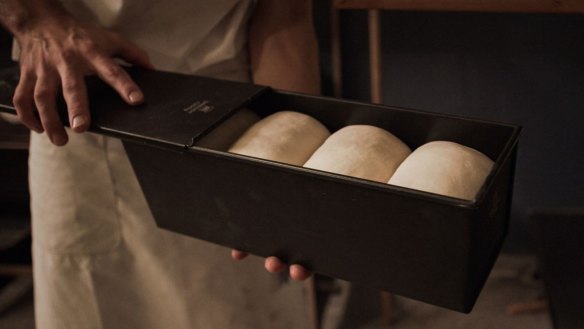
Make your own shokupan
You're best to bake this loaf on a calm day when you have nowhere to be and nothing to do. The first time I made it, one of my dough halves increased in size much faster than the other, and then rose the same way in the oven. It's not a big deal, as long as you don't freak out about not having a perfect loaf. If evenness is important to you, invest in a loaf tin with a sliding lid.
INGREDIENTS
Yudane*
- 100g baker's flour
- 80ml boiling water
Shokupan
- 400g flour
- 300ml milk warmed to 30C (*I found this quite difficult to achieve and ended up heating it to about 70C then letting it cool before adding it to the mix*)
- 20g sugar
- 5g salt
- 6g instant yeast
- 20g butter, softened
- 1 egg plus salt for glaze
METHOD
- The day before you intend to bake, make the yudane starter by combining flour and boiling water to form into a ball. Cover with cling film or pop into a sandwich bag overnight.
- To make the loaf, combine yudane with all ingredients except butter in the bowl of a stand mixer fitted with a dough hook (or by hand if you don't have one) and mix until a dough has formed. Add softened butter and mix for a further 15 minutes or until silky smooth. I did half by machine and half by hand and either works fine.
- Using your hands, form dough into a tight ball, place in a lightly oiled bowl, cover and prove in a warm room with no drafts until the dough has doubled in size, about an hour.
- Place dough on a lightly floured work surface and knock air out of it. You should have a thick, flat disc.
- Divide into two even pieces (this really helps at the proving stage to get the dough to rise faster – you could even divide into three) and shape into balls. Rest, covered, for about 20 minutes.
- Preheat oven to 160C fan-forced (180C conventional).
- Knock back again and shape by folding into two tight parcels, and place both into a greased bread loaf tin, at least 10cm deep to accommodate the dough, which will do most of its rising in the final prove – this should take between 30 minutes and an hour.
- Bake for 35 minutes, then remove from the tin ASAP and cool on a rack so it doesn't continue to steam from the residual heat.
- Let cool before slicing and making a magical sandwich (see Sandoitchi Cafe's buttermilk chicken sando recipe below) or simply slathering in butter.
*Yudane, the milk bread starter or water roux, is very simple and is ready to go within 24 hours. It helps to make the bread softer and last longer.
Sandoitchi Cafe's buttermilk chicken sando
This recipe needs to be started a few days before you intend to eat your sandwich. The flavour and tenderness make it worth the wait.
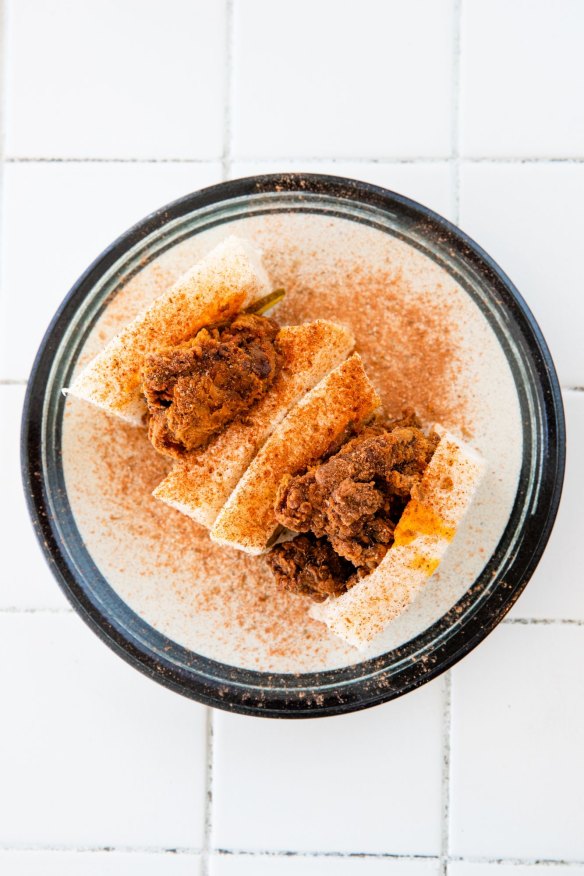
INGREDIENTS
First brine
- 1kg of chicken marylands or thigh, skin on
- white vinegar for cleaning chicken
- 10g coriander root
- 30g garlic
- 20g whole white pepper
- 1 lemongrass stalk, white part only
- pinch sea salt
- 20ml fish sauce
- 20g palm sugar, pounded into small pieces
- 100g water
Second brine
- 800ml buttermilk
- 10g Cajun spice
- 10g ground black pepper
- 10g ground coriander seed
- 10g chilli powder
- 5g garlic powder
- 5g onion powder
- 5g cinnamon powder
- 5g smoked paprika
- 3g ground cloves
- 5g bay leaves
The sando
- 1kg chicken, brined
- plain flour, for coating
- 4 litres vegetable oil, for frying
- 1 loaf milk bread or unsliced white bread
- unsalted butter, for spreading
- chilli mayo (200g Kewpie mayo mixed with 50g sriracha)
- cucumber pickles, for garnish
METHOD
- For the first brine, rinse the chicken with vinegar and drain it well. Pound coriander root, garlic, white pepper, lemongrass and salt to a fine paste with a mortar and pestle. Add the fish sauce, palm sugar and water. Add chicken and marinate, covered, in the fridge for one day.
- For the second brine, mix all the ingredients together. Take chicken out of the first brine, pat dry and add to buttermilk brine. Marinate for one day.
- Take chicken out of brining liquid and coat thoroughly in plain flour. Leave the floured chicken in the fridge for 10 minutes before frying.
- To cook the chicken, preheat vegetable oil to 175C in a large, heavy-based saucepan. Cook, turning the pieces regularly, until the batter is deep golden, about 10 minutes.
- To assemble the sandos, cut 10 thick slices of bread, removing the crusts. Take two slices and spread each side with butter and a squirt of chilli mayo. Place one piece of chicken on the bread, garnish with a pickled cucumber, carefully slice in half. Repeat for remaining sandos. Eat!
Serves 5
From our partners
Original URL: https://www.watoday.com.au/goodfood/shokupan-awe-how-to-make-japanese-milk-bread-and-its-cult-sandos-20200910-h1qmvv.html
